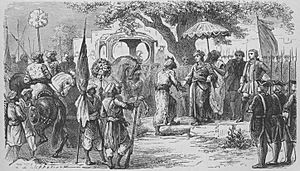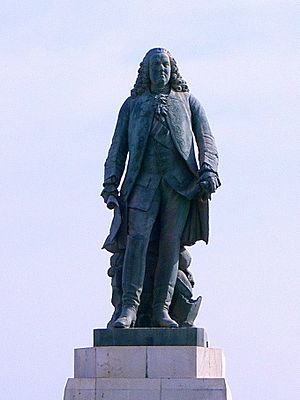Joseph François Dupleix facts for kids
Quick facts for kids
Joseph François Dupleix
|
|
|---|---|
 |
|
| Governor-General of French India | |
| In office 14 January 1742 – 15 October 1754 |
|
| Monarch | Louis XV |
| Preceded by | Pierre Benoît Dumas |
| Succeeded by | Charles Godeheu As Acting Governor-General |
| Personal details | |
| Born | 23 January 1697 Landrecies, France |
| Died | 10 November 1763 (aged 66) Paris, France |
| Spouse | Jeanne Albert |
| Parent |
|
| Occupation | Governor-General of French India |
Joseph François Dupleix (born January 23, 1697 – died November 10, 1763) was an important French leader in India. He served as the Governor-General of French India. He was a major rival of the British leader, Robert Clive, during a time when France and Britain were competing for power in India.
Contents
Early Life and Career in India
Dupleix was born in a town called Landrecies in France on January 23, 1697. His father, François Dupleix, was a rich businessman. He wanted Joseph to follow in his footsteps. To encourage this, his father sent him on a trip to India in 1715. He traveled on a ship belonging to the French East India Company.
Joseph made several trips to both the Americas and India. In 1720, he became a member of the main council in Bengal. He was very good at business. Besides his official work, he also started his own projects. This helped him become very wealthy.
In 1730, Dupleix was put in charge of all French business in Chandernagore. He married Jeanne Albert in 1741. She was the widow of another company official. Local people in India knew Jeanne as Joanna Begum. She was very helpful to Dupleix. She helped him talk and make deals with the Indian princes.
Becoming Governor-General of French India
Because of his strong reputation, Dupleix was chosen for a big job in 1742. He became the Governor-General of all French areas in India. Dupleix noticed that Indian princes often argued over who should rule. He saw this as a chance for France to gain more power in India.
To do this, he started working with the local princes. He also began to live and dress in a grand, royal style, like an Indian ruler. He built his own army of local Indian soldiers. These soldiers were called sepoys. They were trained as foot soldiers for his service. Famous leaders like Hyder Ali from Mysore were part of his forces.
The British leaders became worried about Dupleix's growing power. However, a problem for the French helped the British. Dupleix and Bertrand François Mahé de La Bourdonnais, another French governor, did not get along. Their strong dislike for each other weakened French efforts.

Conflicts with the British
In 1746, the city of Madras was captured by the French after the Battle of Madras. Dupleix did not want to give the city back to the British. This went against a treaty signed by La Bourdonnais. Dupleix then sent his army to attack Fort St David in 1747. He won over the Nawab of Arcot, who was an ally of the British. Dupleix tried to capture Fort St David again and succeeded.
In 1748, the French attacked Kolkata. But during the fighting, news arrived that France and Britain had made peace. This peace treaty was signed at Aix-la-Chapelle. After this, Dupleix started planning to take control of southern India. He sent many troops to help two princes who were fighting for control of the Carnatic and the Deccan. The British then supported the rival princes. They wanted to stop Dupleix's plans from working.
In 1750, the ruler of Deccan gave the Alamparai Fort to the French. This was a gift to thank Dupleix and the French army for their help.
Dupleix also tried to increase French influence in Burma starting in 1751. He sent a special messenger, Sieur de Bruno. He also gave military help to the Mon people in their fight against the Burmese. Bruno was very successful, leading to closer ties between the French and the Mon. However, the start of the Seven Years' War meant France had to focus elsewhere. So, this relationship did not last.
Remembering Joseph Dupleix
Many things have been named in honor of Joseph Dupleix. These include:
- A square, a road, and a metro station in Paris, France.
- Four French warships have been named after him. These include a steam corvette, two cruisers, and a frigate.
- College Dupleix was the old name for two colleges in Chandannagar, India.
- A road in New Delhi, India, near the Indian parliament, is named after him.
- Rue Dupleix (Dupleix Street) was the old name for Nehru Street in Pondicherry, India.
Statue of Joseph Dupleix in Puducherry

Dupleix left Puducherry in 1754. France did not officially recognize his important work until 1870. That year, two statues were made. One was placed in Puducherry and the other in France. The statue in Puducherry is now located on Goubert Avenue, near Rock Beach. It was first put up on July 16, 1870. In 1979, the statue was moved from its original spot in Bharathy park to its current location by the beach.
The statue shows Dupleix as a tall and powerful man. He has a large nose and a strong jaw. Some people say he looks a bit like Oliver Cromwell in his portraits. In the statue, Dupleix wears fancy court clothes. He has a wig and long riding boots. In his right hand, he holds a map of Puducherry. His left hand rests on the handle of his sword.
The government of Puducherry's Public Works Department (PWD) worked to restore the Dupleix statue in 2014.
See also
 In Spanish: Joseph François Dupleix para niños
In Spanish: Joseph François Dupleix para niños

